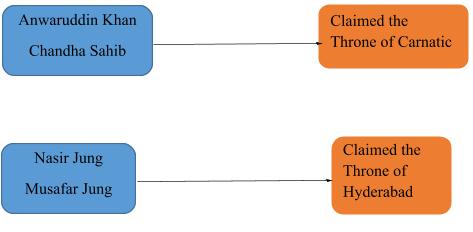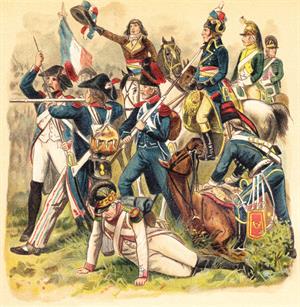
PUMPA - SMART LEARNING
எங்கள் ஆசிரியர்களுடன் 1-ஆன்-1 ஆலோசனை நேரத்தைப் பெறுங்கள். டாப்பர் ஆவதற்கு நாங்கள் பயிற்சி அளிப்போம்
Book Free DemoThe Succession Issue
- After the fall of the Nawab’s forces in the First Carnatic war, the clouds of war never really left the Carnatic Area. A succession issue broke out between the kin of thrones in two different places, the Carnatic and the Hyderabad.
- This issue of Succession made the European forces take sides, and later it was blown out into a full-scale war.

- The French forces supported Chandha Sahib and Musafar Jung to their respective thrones.
- While the British supported Anwaruddin Khan and Nasir Jung. This infighting among the native Nawab’s was seen as a great opportunity by the European forces who were ready to capture the Deccan areas through this battle.
The Second Carnatic War (1749 – 1755)
Dupleix and the French Connection

Dupleix
- Dupleix, the French governor who had successful campaigns during the First war of Carnatic, was appointed the in-charge of the campaigns to unseat the regional powers.

- In Hyderabad, the succession issue was ended by the French intervention where Nasir Jung was killed, and Muzaffar Jung was made as to the Nizam of Hyderabad.
DUPLEIX: He visited India as an officer of the FEIC, who later rose to the ranks of Governor of Pondicherry in \(1742\ \)and became the supreme chief official of FEIC.
Dupleix was rewarded with numerous gifts and was offered provinces by the Nisam. He started his expansion policies during his reign.
The Arcot Battle and the Fall of French power: (1751)
- Dupleix, to show his might and expand the French regime, planned to attack the fort of Trichy, the place of British confidant Muhammed Ali.
- Robert Clive, an astute leader of the British forces, had other plans. He attacked the Arcot, the capital of Carnatic, which was accepted by the then British governor Saunders.
- Clive defeated the French forces and Chandha Sahib, and he was later executed. Muhammed Ali was instated as the Nawab of Carnatic under the protection of BEIC.
- Due to the failure of the French forces in the battle, Dupleix was recalled back to France in \(1754\).
Treaty of Pondicherry: (1755)
- Mutual non-interference in internal affairs.
- Restoring to their original positions.
- No construction of new forts by both the powers.
Seven Year war in Europe
Third Carnatic War (1756 – 1763)

The French forces
- The French government badly need to retain their glory and teach a lesson to the British forces after the earlier debacles. The FEIC appointed “Count De Lally” to get the job done.
- Lally captured Fort St.David, and he asked his Carnatic counterpart General Bussy to ally with him to rout the British power in the South.
- Bussy left Northern Circars (Andhra and Odisha) to assist Lally. Sensing the vacuum in the Northern Circars, Robert Clive quickly sent his deputy to capture it. This hasty decision was considered a blunder by the historians.

Treaty of Paris: (1763)
- The treaty was signed by the British and the French forces, which put an end to the Seven Years War in Europe as well as the problems in the subcontinent.
- The French completely lost their supremacy in India.
- Karaikal, Pondicherry and Chandranagore were handed over to the French company.
- French was prohibited from fortifying their places.